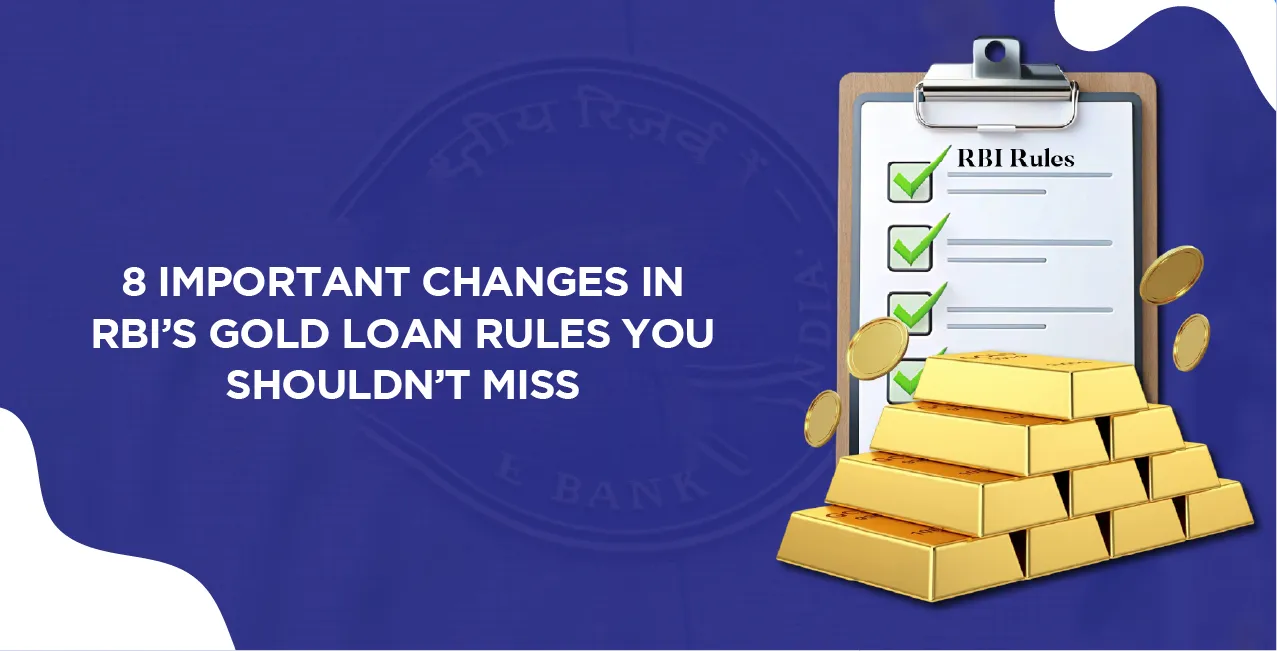
Author
LoansJagat Team
Read Time
5 Min
11 Jun 2025
8 Important Changes in RBI’s Gold Loan Rules You Shouldn’t Miss
On June 6, RBI dropped another piece of good news, apart from cutting the repo rates. The new regulations regarding gold and silver loans are something a small business owner should definitely read about.
The RBI had to take this step, because commercial banks and NBFCs were participating in various irregularities regarding the gold recovery process, initiating NPA inquiries, and charging hidden costs.
“Sona kitna bhi puraana ho, loan toh naya milega!”
1. Higher LTV for Small Gold Loans
Earlier, the maximum Loan-to-Value (LTV) ratio allowed on gold loans was capped at 75%. However, as per the new RBI guidelines, loans below ₹2 lakh now enjoy an increased LTV of 85%, allowing borrowers to access higher amounts for the same quantity of gold.
This will particularly benefit households that rely on gold for emergency funding or working capital needs.
For example, Sita, a freelancer, was in need of emergency funds to expand her agency. Hence, she pledged her gold worth ₹1 lakh with a commercial bank. Read the table below to know the difference between previous and new regulations:
Category | Gold Value | LTV Percentage | Loan Amount Received |
Previous Regulation | ₹ 1,00,000 | 75% | ₹ 75,000 |
New Regulation | ₹ 1,00,000 | 85% | ₹ 85,000 |
Difference | - | 10% | ₹ 10,000 |
However, make sure that the actual value of the pledged gold is less than ₹ 2 lakh to avail this benefit.
“Kya income proof? Ab toh loan seedha haath mein.”
2. No Income Proof for Loans Under ₹2.5 Lakh
This regulation is cherry on the top for informal sector workers, micro entrepreneurs, and rural households. If they want to apply for loans under ₹ 2.5 lakh then they don’t need to submit income proof or go through credit checks.
Here’s how this move benefits the borrower:
Benefits | Impact |
No Income Assessment | Faster loan approvals |
No Credit History Checks | Inclusion of first-time borrowers |
Simpler Documentation | Eases access for rural and low-income groups |
Tailored for Small Ticket Needs | Helps farmers, artisans, and daily wagers |
“Ek saal mein chukta karo, warna bullet loan banega bojh.”
3. Capping on Bullet Repayment to 12 Months
A bullet repayment loan is different from a normal loan repayment. Refer to this table to observe a difference between the 2.
Here’s a quick comparison:
Feature | Bullet Repayment | Regular EMI Repayment |
Repayment Type | Lump sum at end | Monthly instalments |
Interest Burden | Higher due to compounding | Spread across tenure |
Loan Tenure | Now capped at 12 months (RBI rule) | Flexible tenure as per loan agreement |
Risk for Borrower | High if funds not available at maturity | Predictable and disciplined repayment |
As per the new RBI rule, bullet repayment loans must be completed within 12 months, preventing long-term risk buildup and borrower stress.
“Chukta kiya loan? 7 din mein wapas milega sona!”
4. Banks Must Return Pledged Gold Within 7 Days
RBI now mandates that once the borrower repays the full loan amount, banks and NBFCs must return the pledged gold within 7 working days. If commercial banks fail to do so then a fine of ₹5,000 per day will be levied on the bank.
“Agar sona gaya, toh bank bharega har nuksaan.”
5. Compensation for Lost or Damaged Pledged Items
For example, you lend your work notebook to your friend to help him cover up the lag. What would happen if he lost your notebook? Well, RBI now has a regulation for that as well.
If the pledged gold or silver is lost, stolen, or damaged, the bank or NBFC is liable to compensate the borrower at current market rates. This enhances borrower protection and puts pressure on institutions to improve vault safety and tracking systems.
“Auction bhi ab hoga khula-saaf – jaise ek open book test.”
6. Transparent Auction Process for Gold Recovery
In the event of loan default and subsequent auction of pledged gold, RBI now mandates transparent auction procedures. Banks need to follow these guidelines in case of loan defaults:
Guidelines | Description |
Guideline 1 | Proper notice to be served to the borrower before butting the pledged gold to auction. |
Guideline 2 | Reserve price of the pledged gold should be at least 90% of the market value. This limit can be lowered to 85% after failed auctions. |
Guideline 3 | Surplus from auction to be returned to the borrower within 7 working days. |
“Apni bhasha mein samjhao, warna loan mein galti ho jaayegi.”
7. Mandatory Communication in Local Languages
High-end commercial banks have to communicate each and every term of the loan documents in the borrower's local language. This is extremely important in rural and semi-urban areas.
“Sona bhi limit mein, chandi bhi limit mein.”
8. Limits on Gold and Silver Pledge for Loans
The RBI has imposed limits on the quantity of gold and silver against which a borrower can apply for loans. Refer to this table below to know these limits:
Category | Limits |
Gold Ornaments | Up To 1 Kg |
Gold Coins | Up To 50 Grams |
Silver Ornaments | Up To 10 Kg |
Silver Coins | Up to 500 Grams |
RBI Ka “Gold Standard” Loan Norms
Gold loans should be accessible to the rural public and small scale entrepreneurs, this seems to be the RBI’s goal while framing these regulations.
Whether you're planning for a child’s education, covering emergency expenses, or funding a business, these changes could help you get more value, more protection, and more transparency from your gold.
Other News Pages | ||
About the Author

LoansJagat Team
‘Simplify Finance for Everyone.’ This is the common goal of our team, as we try to explain any topic with relatable examples. From personal to business finance, managing EMIs to becoming debt-free, we do extensive research on each and every parameter, so you don’t have to. Scroll up and have a look at what 15+ years of experience in the BFSI sector looks like.

Quick Apply Loan
Subscribe Now
Related Blog Post

LoansJagat Team • 10 Jun 2025

LoansJagat Team • 06 Jun 2025

LoansJagat Team • 22 Sep 2025